Need stakeholder buy-in for your project? See why it’s so important to map stakeholders. We’ve put together this crash course on when, why, and how to map stakeholders. We also look at fit-for-purpose stakeholder mapping tools teams can use to better navigate their ever-changing stakeholder landscape.
Stakeholder mapping – What is it?
Stakeholder mapping is an invaluable exercise for any stakeholder management team. This stakeholder engagement best practice lets you visualize your evolving relationships with stakeholders to understand who has power or influence over your project. This analysis lets you identify and engage with stakeholder more effectively.
What is a stakeholder map?
A stakeholder map is a snapshot of your stakeholder landscape at a given point in time. It’s often depicted as a graph with 2 axes divided into 4 quadrants:
- The x-axis represents a stakeholder’s level of power or influence over your project.
- The y-axis indicates their level of interest in your project.
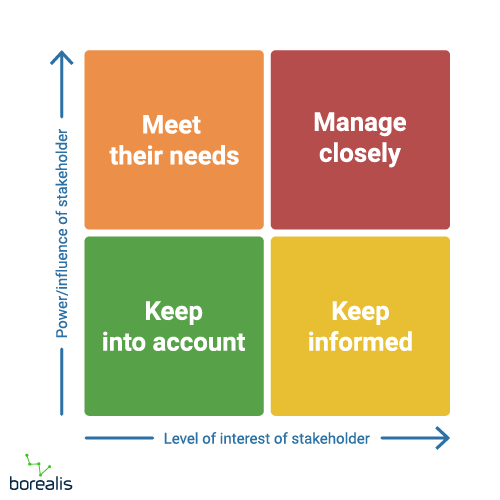
Each quadrant on the map requires a different engagement strategy. A stakeholder’s position on the map will determine how you engage with them, including the intensity and frequency of engagement.
By periodically remapping your stakeholders, you can see how their positions change over the life of your project. This allows you to alter your stakeholder engagement strategies accordingly.
What is a stakeholder mapping template?
Why is stakeholder mapping important?
Stakeholder mapping provides essential insights for creating effective stakeholder engagement strategies. In turn, effective engagement helps you build trust with stakeholders and lead your project successfully over the finish line.
Stakeholder mapping supports project success in several ways:
- By identifying all relevant individuals, groups, or organizations that might impact or be impacted by your project, you can make sure no important group is overlooked.
- Highlighting the relationships, influence, and interests among different stakeholders allows you to better understand their dynamics and interactions.
- By classifying stakeholders based on their influence and interest, you can prioritize your engagement efforts to focus on those who have the most significant impact or those most affected by the project.
- Understanding stakeholders’ positions and interests makes it easier to craft personalized communication strategies to ensure the right message reaches the right stakeholder.
- By identifying potential areas of concern, resistance, or opposition early on, you can anticipate and address potential challenges proactively, before they become project risks.
- By understanding which stakeholders are most critical, you can allocate your resources—time, money, and effort—more effectively.
- By engaging the right stakeholders at the right time, you can increase support for your project and pave the way for smoother implementation.
- A clear stakeholder map establishes channels for regular feedback, allowing you to address emerging concerns or changing conditions promptly.
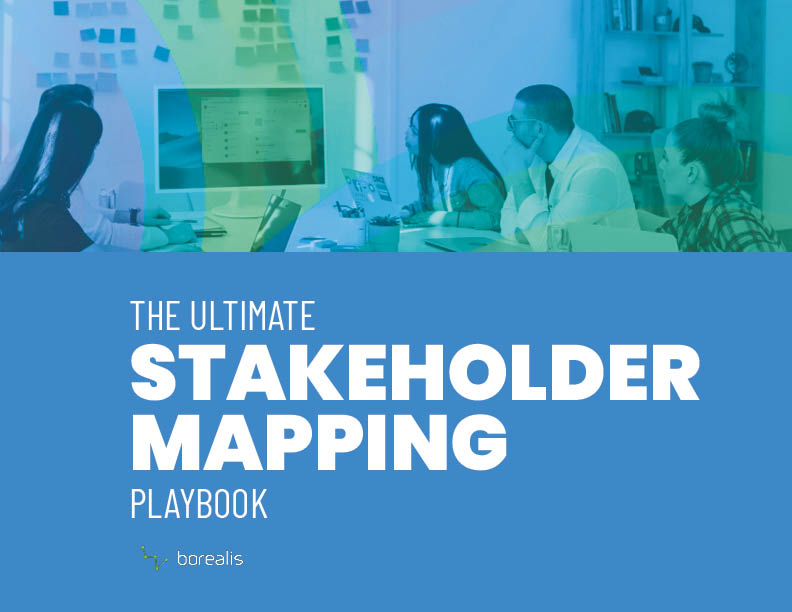
Get a crystal-clear picture of your stakeholder relationships to inform your engagement strategies.
What is the purpose of stakeholder mapping?
Stakeholder mapping is a strategic process used to identify and analyze individuals, groups, or entities that have an interest in a project or business initiative. Its purpose is to understand stakeholder perspectives, influence, and potential impact on the project’s success.
By categorizing and prioritizing stakeholders, organizations can tailor their communication and engagement strategies to ensure stakeholders’ needs and concerns are adequately addressed.
In short, stakeholder mapping is the corner stone that will help you optimize engagement through strategic insights.
What are the risks of not mapping stakeholders?
11 stakeholder mapping techniques and when to use them
There are a variety of techniques you can use to map and analyze stakeholders. The choice of which stakeholder mapping technique to use often depends on the specific context, needs, and goals of the project or initiative.
Here is a brief description of what each stakeholder mapping technique entails, along with a general guideline on when each technique might be most appropriate:
1. Power-interest grid
When to use a power-interest grid

2. Influence-interest matrix
When to use an influence-interest matrix
When you want to focus specifically on the direct influence stakeholders. A good example can be found in event that took place not so long ago. A government agency responsible for implementing a vaccination campaign, such as a vaccination drive, might use an influence-power stakeholder map. In this context, they would identify and assess stakeholders like healthcare professionals, community leaders, pharmaceutical companies, and policymakers. This mapping would help them evaluate the level of influence and power each stakeholder exercises in promoting or hindering the vaccination campaign’s success, allowing for targeted engagement and strategic decision-making.
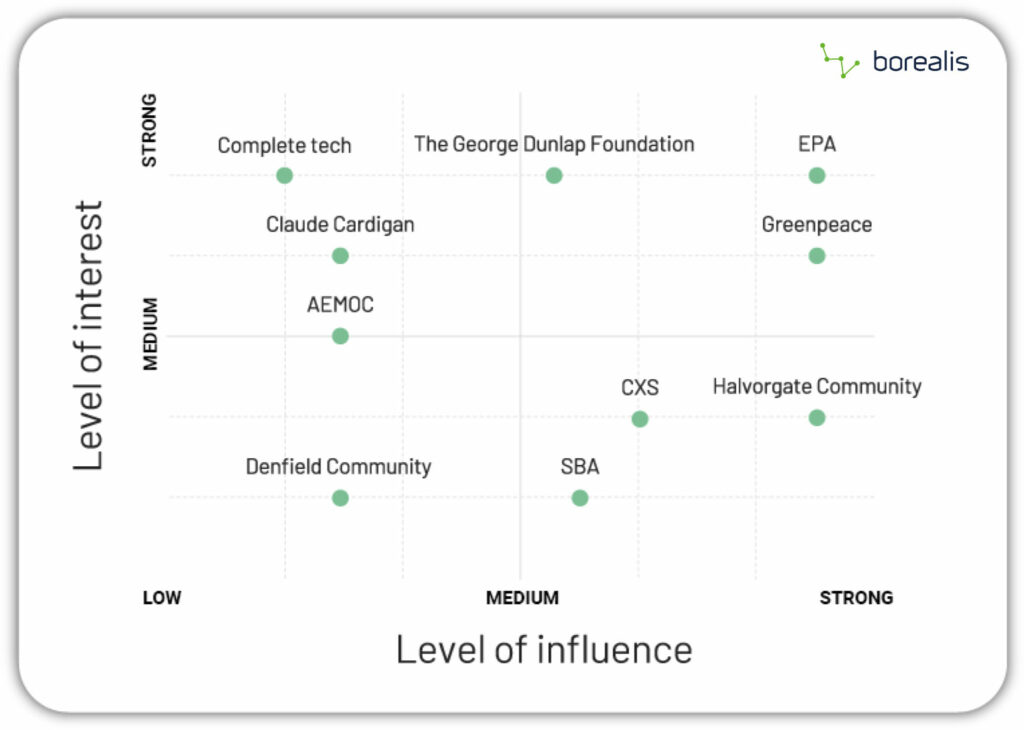
3. Power-dynamism matrix
When to use the power-dynamism matrix
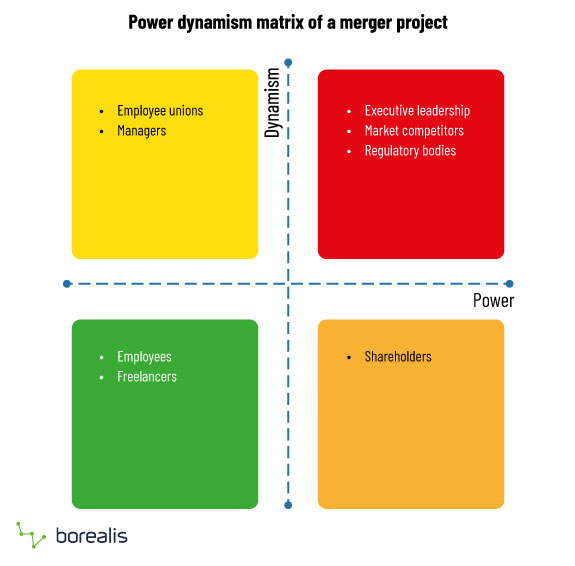
4. Salience model
When to use the salience model
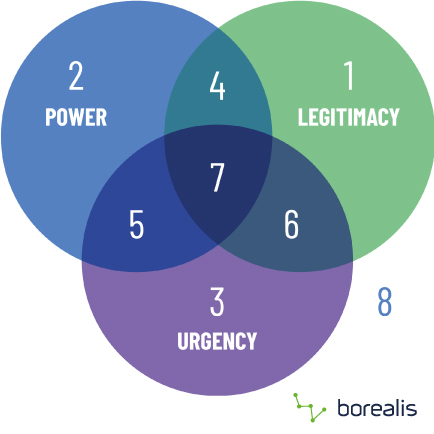
5. Stakeholder influence diagram
When to use a stakeholder influence diagram
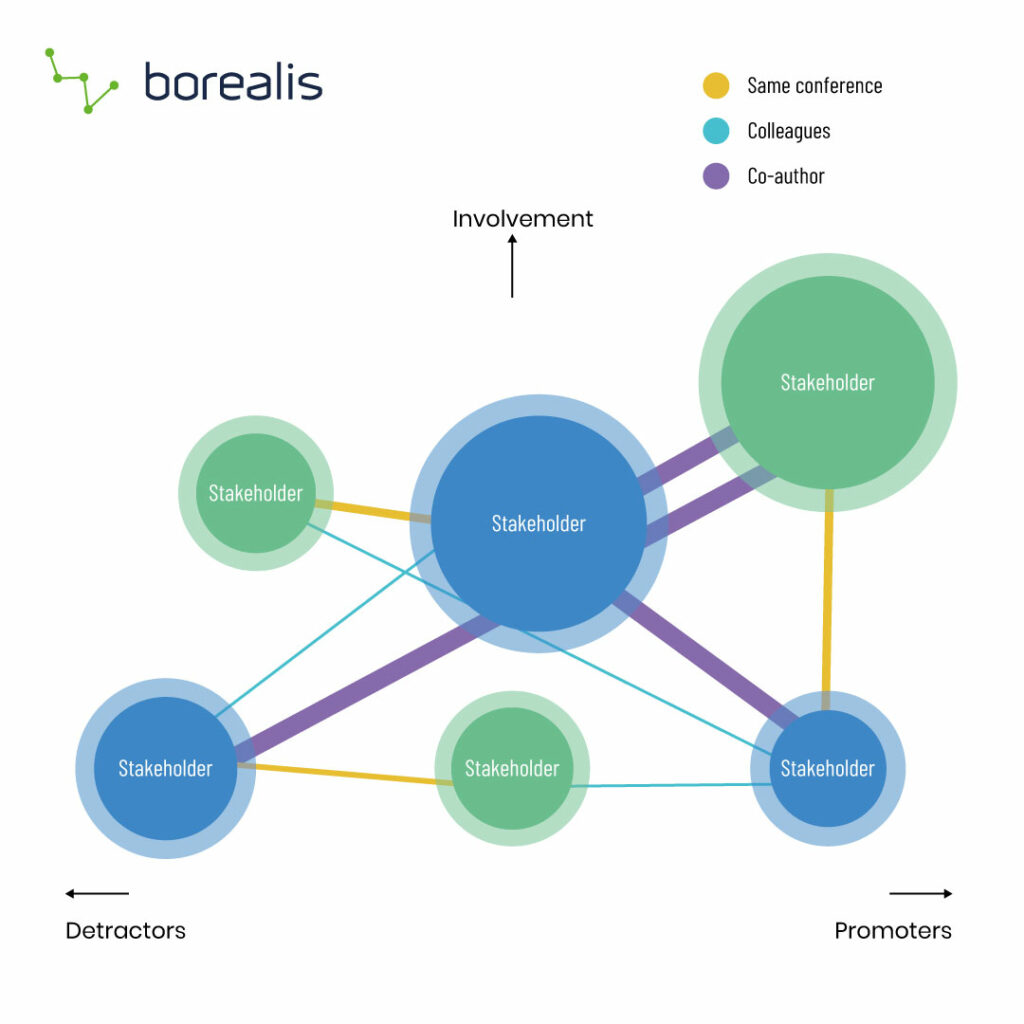
6. Stakeholder-centric network analysis
This is an advanced stakeholder mapping method that employs network theory concepts to understand the relationships and the flow of information or influence among a group of stakeholders.
When to use a stakeholder-centric network analysis
In large-scale projects or in organizations with complex internal structures where understanding the intricacies of the stakeholder network can lead to better communication and project strategies.
Think of a technology company launching a new product in a highly competitive market. In this scenario, the company would take of the stakeholder-centric network analysis to identify and assess a wide range of stakeholders, including customers, suppliers, distributors, industry influencers, regulatory bodies, and competitors.
Using this type of stakeholder mapping matrix could help the business understand the intricate web of relationships within its industry and enable them to:
- Identify key players who have the most significant impact on market trends and decisions.
- Determine potential partners for collaborations.
- Identify gaps in their network that need to be filled to strengthen their market position.
- Anticipate market shifts and emerging trends by monitoring the flow of information and influence within the network.
By conducting a Stakeholder-centric network analysis, the technology company can develop a more comprehensive and strategic approach to product launch and market penetration, ensuring they effectively engage with and leverage their network of stakeholders for success.
7. Stakeholder value network
When to use a stakeholder value network
For projects or initiatives where understanding the flow of tangible and intangible value (like information, resources, or influence) between stakeholders is critical. In the context of a large-scale wind farm project in a rural area for example. In that scenario, the renewable energy company could leverage the stakeholder value network analysis to understand the value exchange and interdependencies among these stakeholders in the context of the wind farm project.
They could discover that :
- Local residents value job opportunities and social investment in the community resulting from the project but are concerned about environmental impact and property values.
- Environmental groups are critical of its impact on local ecosystems but cherish the project’s potential to reduce carbon emissions.
- Utility companies are pleased by the announcement of new source of renewable energy but also have specific requirements for the project’s energy output.
- Regulatory agencies are only positive. They value compliance with environmental regulations and economic benefits for the region.
The Stakeholder Value Network analysis would involve mapping these stakeholders, their values, interests, and dependencies. It would help the renewable energy company identify areas of alignment and potential conflicts among stakeholders.
8. Stakeholder culture analysis
When to use a stakeholder culture analysis
For multinational or cross-cultural projects where cultural dynamics can significantly influence stakeholder perceptions and actions. Let’s take a global clothing retailer expansion for example.
Let’s imagine a clothing retail brand with a presence in the United States wants to open new stores into several countries across Europe, including France, Germany, and Italy. This expansion will involves dealing with various stakeholders. The organization used the stakeholder culture analysis scheme and was able to uncover information that will help team make more strategic decisions.
Each country has its unique fashion preferences, style trends, and cultural influences on clothing choices. The local shopper cultural analysis should helps the retailer curate its product offerings to align with local fashion sensibilities while maintaining its brand identity.
Collaborating with local retail partners or franchisees may require an understanding of their cultural values, business practices, and negotiation styles. Cultural analysis can foster productive partnerships and ensure consistency in brand presentation.
Different countries have varying regulations related to clothing labeling, sizing, and import/export policies. Cultural analysis may help get an overall picture of how and why some regulations are applied thus ensuring the clothing complies with local standards and preferences.
Identifying and engaging with local fashion influencers or bloggers who align with the brand’s values and resonate with the local culture can be a powerful marketing strategy.
And last but not least, observing and mapping the cultural strategies and tactics of both local and global competitors is essential for market positioning and staying ahead in the fashion retail industry.
By conducting a Stakeholder Culture Analysis, the clothing retail brand will gain insights into the cultural factors influencing stakeholder behaviors and preferences in each target market. This kind of mapping exercise will be key to inform product selection, partnership negotiations, marketing campaigns, and compliance efforts, facilitating a successful expansion into new regions while respecting and embracing local cultures and fashion trends.
9. Issue-based stakeholder mapping
When to use an issue-based stakeholder culture analysis
| Stakeholder groups | Issues most concerned with | |
|---|---|---|
| Environmental non-profits | Organizations dedicated to promoting environmental sustainability and advocating for stricter regulations. |
|
| Industries associations | Representing sectors that might be impacted by the regulations, such as energy, manufacturing, and transportation. |
|
| Government agencies | Responsible for drafting and enforcing the regulations. |
|
| Local communities | Residents and community leaders in areas directly affected by industrial operations. |
|
| Scientific experts | Researchers and scientists with expertise in climate change and environmental impacts. |
|
| Economic analysts | Experts who can assess the economic implications of the policy change. |
|
10. Stakeholder profile
When to use stakeholder profiling
11. Stakeholder mapping by geographic distribution
When to use stakeholder geographic distribution mapping
In projects that involve siting, constructing, maintaining or decommissioning assets that may be located directly on or in proximity to stakeholder land. A good example could be found in Pipeline maintenance activities.
Before maintenance activities, teams must contact various stakeholders for reasons like negotiating right-of-way agreements, documenting land access conditions, notifying occupants about work, ensuring legal compliance, securing permits, coordinating with suppliers, recording concerns, and more.
Learn how a stakeholder management tool with GIS mapping capacities can boost stakeholder management strategies.
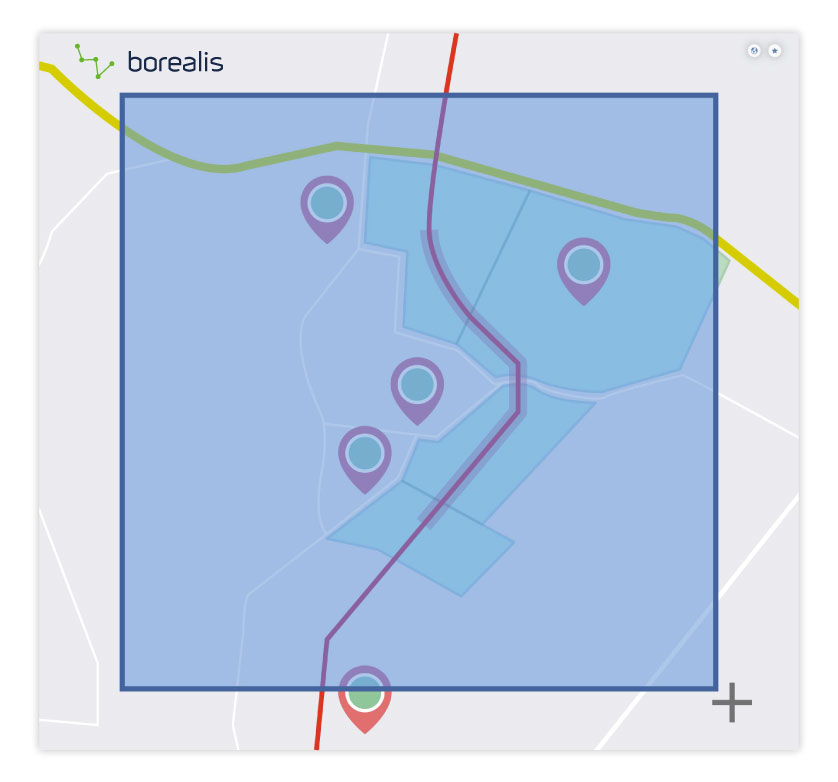
Learn how a stakeholder management tool with GIS mapping capacities can boost stakeholder management strategies.
Strengths and weaknesses of each stakeholder mapping technique
Each stakeholder mapping technique has its own pros and cons. This is why larger, high-stakes projects tend to use a combination of techniques.
| Technique | Pros | Cons | |
|---|---|---|---|
| 1. | Power-interest grid |
|
|
| 2. | Influence-interest matrix |
|
|
| 3. | Power-dynamism matrix |
|
|
| 4. | Salience model |
|
|
| 5. | Stakeholder influence diagram |
|
|
| 6. | Stakeholder-centric network analysis |
|
|
| 7. | Stakeholder value network |
|
|
| 8. | Stakeholder culture analysis |
|
|
| 9. | Issue-based stakeholder mapping |
|
|
| 10. | Stakeholder profile |
|
|
How to choose the right stakeholder mapping technique
The best stakeholder mapping technique often depends on three things:
- The nature and complexity of the project
- The organization’s familiarity with its stakeholders
- The specific goals of the mapping exercise
For instance, a small local project might just need a simple power-interest grid, while a large international initiative might benefit from a combination of several mapping techniques. Many multi-year, large-scale infrastructure projects, such as those found in mining, energy, and transportation will often use stakeholder management software which includes extensive stakeholder mapping capabilities.
Regardless of the technique, the ultimate goal is to better understand and manage stakeholders to ensure a successful outcome for the project or initiative.
How to create a stakeholder map
Below is a simple approach that the Borealis team has established through our work with clients over the past 15 years, based on the proven 3-stage stakeholder engagement methodology of plan-engage-measure. By following this stakeholder mapping approach, you can ensure all key stakeholders are properly identified and accounted for.
So, what are the steps to build a stakeholder map?
Step 1: Identify & categorize stakeholders
First, identify all of your stakeholders. Who are they? Stakeholders include any individuals, companies, or institutions who may impact – or be impacted by – your project, positively or negatively.
They can be government agencies, local communities or associations, consumers, employees, suppliers, elected officials, and more. As you create your list, ask yourself, who will be affected? Who will support the project? Who will oppose it?
Use different strategies to identify stakeholders, such as brainstorming, focus groups, consultations, research, historical data, and grievance logs.
Step 2: Classify stakeholders
Next, categorize this list of stakeholders into groups. How, exactly? Start by defining broad groups with similar interests and needs. Next, try to break these groups into smaller subgroups based on industry, context, history, location, and other criteria.
Ask yourself, which individuals have similar interests? Which have similar needs? What do these people have in common?
This will help you streamline your messaging to communicate effectively with each group. For example:
Government and regulatory authorities
- Governments
- Local and national regulatory bodies
- Elected representatives
- Public advisory committees
- Police and emergency services
Communities affected by the project
- Populations near your project
- Job seekers
- Vulnerable groups: women, elders, etc.
- Religious groups
- Universities and other educational institutions
Companies and commercial organizations
- Suppliers
- Service providers
- Partners
Internal stakeholders
- Board(s) of directors
- Directors
- Employees
- Investors
Step 3: Analyze stakeholders
In order to map your stakeholders, you’ll first need to assess them. This will help you focus your efforts on those with the most power and influence over your project.
Before you begin your analysis, decide which criteria you will use to identify the ‘key stakeholders’ for your organization. Remove anyone from your list that doesn’t meet those criteria.
A thorough stakeholder analysis will help you evaluate the risks and opportunities these different groups present to your project. This will help you determine why, how, and how often you need to engage with them. Be sure to rank each stakeholder’s levels of interest and influence, as you’ll need this information for stakeholder mapping.
You can assess these elements in different ways, depending on your needs. A simple option is to break each category into two levels: low and high.
Let’s look at two examples for a proposed solar energy project.
- One of your stakeholders is a local company named Complete Tech. They have low influence in your project, but their level of interest is high. (They’re hoping you’ll hire them as a subcontractor.)
- Another stakeholder for your project is the EPA. They have significant interest and influence in the project since their mandate is environmental protection.
Example: Ranking key stakeholders according to influence and interest.
Note: Keep in mind that the quality of this analysis depends on the information you have available. In an ideal situation, anyone involved in the analysis would have a deep understanding of each key stakeholder. When this knowledge is incomplete – or worse, inaccurate – the analysis won’t be as effective.
Step 4: Map stakeholders
Now that you’ve assessed your key stakeholders’ levels of interest and influence, plot them on the grid. In our example, Complete Tech ends up in the bottom-right quadrant and the EPA is at the top-right.
Example: Plotting stakeholders on the Influence/Interest matrix
Their position in the map determines how you’ll engage with these organizations. Complete Tech is a high influence/low interest stakeholder, so you’ll want to keep them informed as the project unfolds. In contrast, the EPA ranks high for both interest and influence, so you’ll need to manage them closely.

How stakeholder engagement software can simplify stakeholder mapping
Modernizing business processes with fit-for-purpose tools can dramatically improve relationships, productivity, and outcomes. This applies to stakeholder management as well. Borealis stakeholder software helps teams extract valuable insights from stakeholder data to create more dynamic, actionable stakeholder engagement strategies.
- The stakeholder mapping tools in Borealis are part of a single, fully integrated platform that helps you manage all stakeholder engagement activities in one location.
- Easily build as many stakeholder maps as you need – by project, by community, or by topic.
- Archive previous assessments to monitor changes in stakeholder interest and influence over time.
- Use custom dashboards to monitor trends in real time in order to respond quickly and proactively.
- Assess stakeholders on up to 8 axes: position, impact, importance, influence, reach, legitimacy, priority, and interest.
- Click on any map, graph, or list to drill down into your data for additional insights.
- Prepare a messaging campaign targeting highly influential stakeholders in just a few clicks.
- Use built-in quality control reports to manage data quality and spot potential issues – like holes in your data that can lead to faulty or incomplete reports – before they can cause problems.
- Coordinate your efforts across teams to build trust with stakeholders and increase their willingness to engage.
Want to learn about stakeholder mapping with Borealis software?
How often should you map stakeholders?
Stakeholder mapping is an ongoing exercise. You’ll want to perform your first analysis early in your project, as it will provide insights to help you proactively develop your engagement strategies. But it’s just as important to re-evaluate stakeholder mapping regularly over the life of your project.
As a project unfolds, stakeholders come and go, and their interest in the project may change. Remapping stakeholders on a regular basis will show you how their positions – and your relationships with them – change as things move forward.
Whether you choose to review your stakeholder mapping every six months or just before each new project stage, be sure to allocate the necessary resources for these important assessments. With each new analysis, it’s important to update your engagement strategies and messaging accordingly.
You’ll also want to have powerful analytics to know if your engagement strategies are bearing fruit.
Teams that prioritize stakeholder mapping from the start often find their stakeholder engagement efforts more productive and efficient. This greater efficiency leaves more time for regular reassessments. That, of course, leads to further efficiency gains and better outcomes. It’s an upward cycle of constantly improving knowledge and results.

Stakeholder mapping example
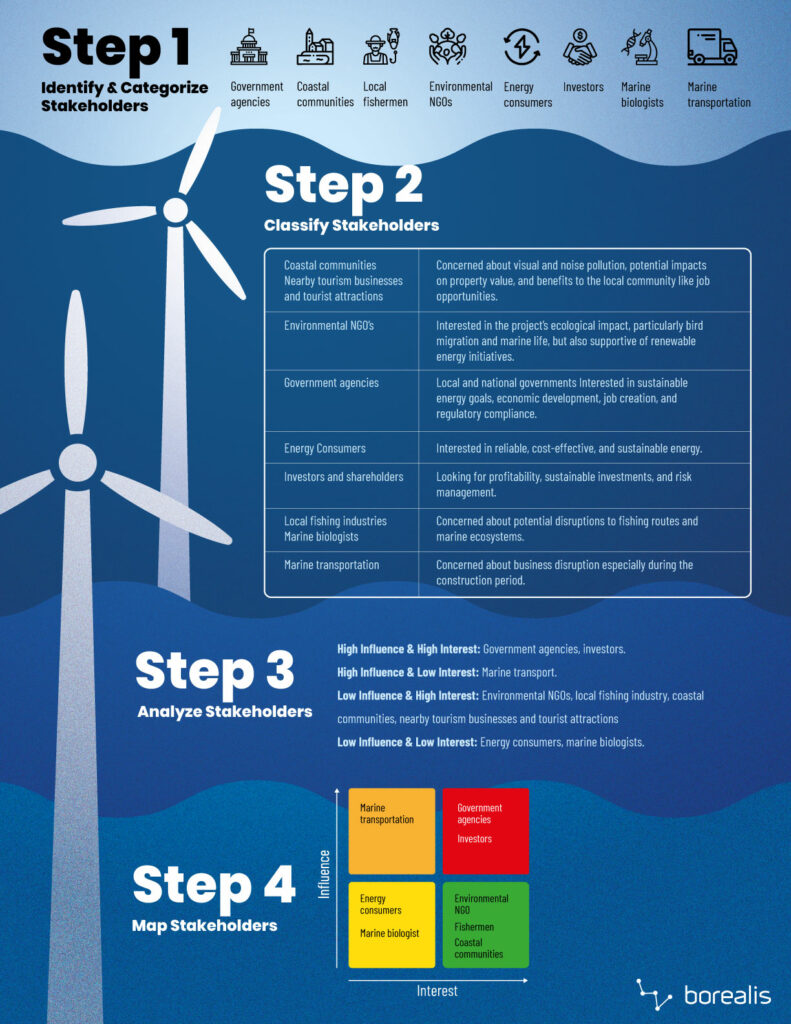
How stakeholder mapping helps builds better stakeholder relations
When stakeholders feel respected and heard, they are more likely to work with your organization in a productive, mutually beneficial manner. Stakeholder mapping helps you understand their concerns, needs, and motivations, so you can engage more effectively.
Building trusted relationships with your stakeholders puts your organization in a much stronger position to minimize potential conflicts and mitigate any negative environmental, social, and economic impacts.
At a minimum, integrating stakeholder mapping into your process will transition your team from a reactive approach to more proactive stakeholder management.
What tools can you use to create a stakeholder map?
Traditional tools
These are great for learning the basics of stakeholder maps and are often used in classroom exercises.
Traditional tools typically include:
- Paper and Pencil: For initial brainstorming and sketching.
- Whiteboards: Great for collaborative sessions with team members.
- Sticky Notes: Useful for categorizing and moving stakeholders around during a session.
General software
This is often commonly-used business software used by small teams with limited budgets. This software is not specifically designed to map stakeholders, but is flexible enough to create basic stakeholder maps.
General software typically includes:
- Microsoft Excel or Google Sheets: Can be used to create grids and categorize stakeholders.
- Microsoft PowerPoint or Google Slides: Useful for creating visual diagrams, especially if presenting to a team.
- Mind Mapping Tools: Software like MindMeister or XMind can be useful for creating visual representations of stakeholder relations.
GIS (Geographic Information Systems)
These systems are extremely useful in land-based or other projects where the geographical location of stakeholders matters.
GIS systems typically include:
Graphics software
Programs like Adobe Illustrator or Canva can be used for designing more polished, presentation-ready stakeholder maps.
What are the disadvantages of mapping stakeholders in a spreadsheet?
Poor version & quality control
Poor data privacy control
Some stakeholder mapping techniques may entail working with a fair amount of stakeholder personal information. Whether the spreadsheets are stored on individual computers or in the cloud, they have limited mechanisms for maintaining the security and confidentiality of this personal information. Even password-encrypted spreadsheets may not be sufficient for meeting the requirements of privacy laws like GDPR.
Poor data accessibility
What are the benefits of using a fit-for-purpose stakeholder management software
Specialized stakeholder management software:
- Centralizes and structures all data in a single, secure location. Information is complete, up to date, and instantly accessible, anywhere, from any device.
- Creates a lasting institutional memory of historical data so that you can build on lessons learned.
- Makes it easy to generate professional reports on demand, or schedule them to be sent to the right people by email at your chosen frequency.
- Has a centralized database that serves as a single point of truth. Teams have a complete picture of project and stakeholder data at all times, allowing them to work more efficiently, make more informed decisions, and manage stakeholder relationships more proactively to achieve better outcomes.





